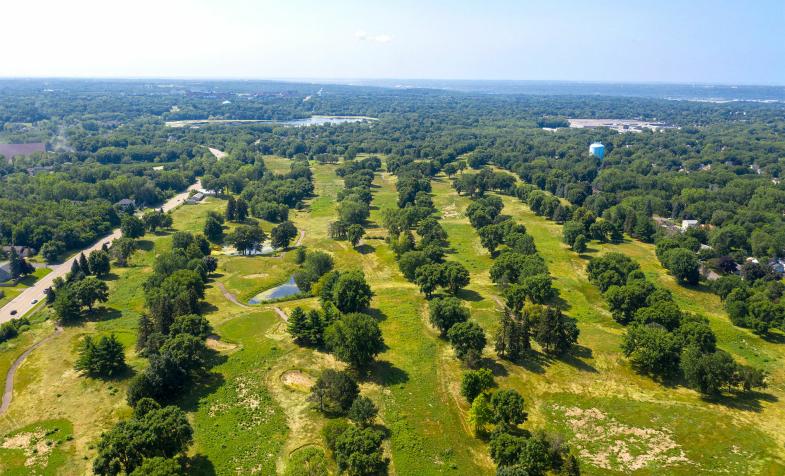The Hillcrest Redevelopment: Teeing Off
The Hillcrest Redevelopment: Teeing Off
This is the first part in a multi-part series on the Hillcrest Golf Course Redevelopment Master Plan.
How do you introduce 1,000 jobs and 1,000 homes on a 100-acre former golf course in a quiet corner of Saint Paul?
That is the challenge facing Cuningham over the next eight months as we prepare a master plan for the redevelopment of the Hillcrest Golf Course. The site, located on the far northeast corner of the city, at the high point of Ramsey County, is one of Saint Paul’s “big six” – a group of sites identified in the city’s Comprehensive Plan as large properties where new jobs and housing can be added.
Currently, the former golf course is in the initial stages of environmental remediation after closing in 2011. Though Hillcrest’s shuttering was a loss to the community, it has opened up a generational opportunity for Saint Paul to add needed jobs, community services, housing, and open space to the city’s East Side.
The plan, which is being developed over the next eight months in concert with the city, the neighborhood, jurisdictional partners, and the Saint Paul Port Authority, is intended to begin construction in 2022. Thus, the role of the master plan is to deliver a vision and framework for how the site will be developed over the subsequent 20 years.
A Unique Redevelopment
The Hillcrest Golf Course redevelopment differs from other redevelopment projects in the metro for several reasons. Namely, unlike most large urban redevelopment sites (such as the Ford Site in Saint Paul) where efforts tend to focus on re-introducing natural systems (landscape and habitat) into an industrial area, the Hillcrest project must do the opposite – it must introduce urban uses into an existing landscape of hills, wetlands, mature trees and considerable topography.
Complicating matters further is the fact that the existing landscape, though lush and visually green, is heavily contaminated and in need of remediation. Though the site appears to be a greenfield, it is not. After receiving heavy fertilization for 100 years, there is significant mercury contamination in the soil. Remediation will include significant soil removal and excavation before the site can be redeveloped.
As the team looks to create a new framework for growth, sustainability will play an important role. The team is striving for a “Carbon Free, Habitat Rich” outcome in which the site generates as much energy as it consumes, restoring and improving the habitat for human, animal and plant communities.
[gallery size="large" mkslideshow="true" ids="25225,25223"]
Meeting the Needs of City and Site
The City of Saint Paul is committed to reducing its carbon, and it hopes projects like the Hillcrest Golf Course Redevelopment will be a bellwether for similar projects in the surrounding region. To support the city’s carbon reduction goals, Cuningham developed a district-wide energy model that measures carbon output by analyzing key metrics such as overall energy use and onsite energy production. With this tool, the team can develop a land use and building program that pushes the project to become carbon-free.
At the same time, the site is located along a habitat corridor defined by wetlands and mature trees. Therefore, the team is also developing strategies to enhance the quality of the natural environment. After completing an initial phase of data collection and public engagement, the team identified several main issues. These issues include:
- What does it mean to fit into the east side of Saint Paul? How can the culture and history of the east side inform the development of the site?
- How can this project write its own unique sustainability story?
- How can 1,000 light industrial jobs coexist with 1,000 households on a relatively tight site with rolling topography?
- How will the project deliver on Saint Paul’s promise to be innovative, equitable, and resilient?

Next Steps
In the upcoming months, the team will develop concept alternatives to test out different approaches for developing the site. These approaches to landscape reshaping will vary in their aggressiveness — an intentional effort to consider all possible options. Each of these approaches will then be measured against community priorities, as well as a carbon calculator developed for the project. We will vet the approaches with all the partners and the Community Advisory Committee before sharing them publicly at the end of the summer.
